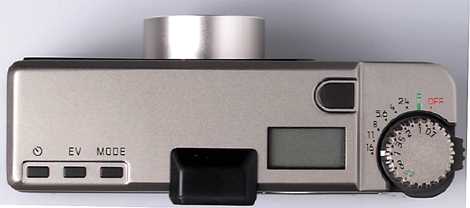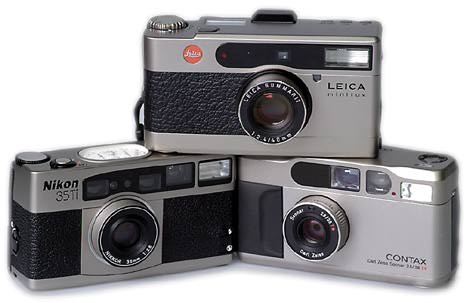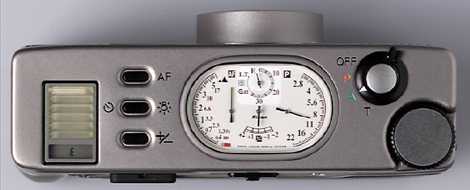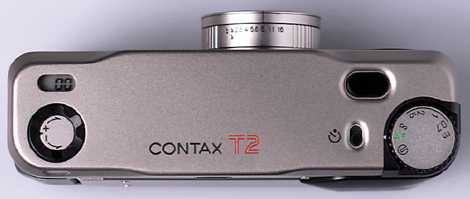

No photographer should go anywhere without a camera. When the aliens land in the supermarket car park or Elvis pops into the pub for a quick half, your CaNikOlympytax 2000 GTxi is going to be no use whatsoever if it's still in the bag in the spare room.
Obviously you donÕt want two SLRs hanging off your shoulder while buying your baked beans so what is the solution? A compact?
Yes and no. Compacts have the advantage of size but most are designed for the amateur market and the plastic bodies and lenses are not up to professional standards.
Their versatility is highly questionable with little, if any, control over exposure. Many now have wide-ranging zoom lenses but this is less useful than it may appear. To retract a zoom lens into a compact body requires some compromises in optical quality and usually results in unacceptably slow maximum apertures. It is more sensible to choose a camera with a fixed lens of a moderately wide angle with a more useful maximum aperture.
Thankfully there is a new breed of just such cameras, designed particularly for the experienced photographer, which fulfil just these criteria.
They are expensive and find two markets Š as luxury goods or status symbols, and as working tools for professionals. The latest of these is the Leica Minilux which we pitted against the already established Nikon 35Ti and Contax T2. All three have titanium outer shells and clearly aim for exactly the same sector of the market. It is fair to say that the Nikon and Leica are Contax T2 lookalikes, even though they bear little resemblance to it. They are deliberate head-on competition.
If there is any other downside, it is the slow and noisy manner in which the lens appears from the body. None of the three is silent, but the Contax is at least fast and noisy and the Nikon slow and quiet. The Minilux combines the less favourable traits of both rivals.

Although the largest of the trio, the Leica is still diminutive enough to fit in a small pocket and handles very well A simple thumbwheel selects Off, Program or Aperture Priority modes from f/2.4 to f/16, regrettably with no half-stop option.
This means that closing down from the exceptionally fast f/2.4 maximum aperture the next option is f/4; there is no provision to use f/2.8, which we would expect to show a significant quality gain compared to f/2.8 on a lens used at full aperture. There is every external sign that the f/2.4 lens already uses an optical design based on f/2 and restricted to f/2.4 to ensure ultimate quality. But f/2.8 would have been useful Š as would f/3.5, an option on both the Nikon and Contax models tested.
The lens quality is, perhaps as a result of these idiosyncracies, the primary reason to buy the Leica. The 40mm f/2.4 Summarit displayed remarkable central resolving power at full aperture, freedom from vignetting, and no hint of corner softness at full bore. Our tests showed this clearly, and reports from early users indicate that 20 x 30" prints present no problem. I found the 40mm lens a little restricting for everyday use compared to the wider 35mm and 38mm of the other cameras, but others may well prefer the 'longer' focal length.
During its time in and around the office the Minilux has been widely dubbed "ugly" both by staff and the photographic proletariat. We have a 1939 Leica III in the office, as well, and even non-photographers remark on how attractive it looks and how good it is to hold. The boxy Minilux with its half-covering of leatherette gets no such praise. The Contax T2 comes closest to echoing (almost exactly) the precise form of edge chamfering used in the old Leica III. Why did Leitz choose a square box shape like an old Argus - or a new Nikon 35Ti - instead of keeping to their own well-founded design principles?
Exposure, general handling and reliability appear to be first-class, and in the light of the speed and supreme sharpness of the lens, we have to assume that viewfinder and design considerations will take a back seat. Price and performance will make the Minilux first choice for most new buyers in this bracket.
On the top is a unique analogue display that resembles nothing ever seen on a camera - the shutter, distance and aperture (etc) displays are based on chronometers or scientific instruments using needles.

This "gimmick" just happens to work surprisingly well. Indeed this is the only camera here which will tell you the focusing distance and the aperture selected by the program mode - even if you do have to peer into the viewfinder to see which shutter speed you are using.
The viewfinder itself also offers illuminated frame marks in low light and flash status and only falls short on eye relief for us speccy types. The program mode is backed by Aperture Priority with half-stop options from f/2.8 to f/22 which are easily adjusted with the thumbwheel.
One serious and very disappointing drawback is that there is no AE lock by half pressure on the shutter as featured on the Contax and Leica - which means that the only real exposure over-ride is by using the + or - 2 stop exposure compensation, a feature common to all three cameras.
However, the Program mode is shiftable, which is unique in a camera of this type. For your extra money you also get a panorama option, standard (switchable) databack and best of all a 35mm lens which, for me, was the most useful of the three.
There is also the option of the 28Ti at the same price and with identical features but a 28mm f/2.8 optic, and which is finished in black.
The Nikon lens produced some of the best-looking negastives. There was no corner fall-off or vignetting, and images were particularly crisp visually, but fine detail resolution of the subject was no match for either the Leica or Contax at f/2.8. Stopped down it was indistinguishable.

It has one feature in particular that leaves the others standing - only the T2 has any kind of manual focus confirmation. The Nikon and Leica are only useful for zone focusing, but the Contax can be focused quickly and accurately under most conditions with LED confirmation in the finder.
Setting of exposure in aperture priority mode is by the familiar aperture ring around the lens. Although intuitive, the ring is very small and proves a little fiddly for larger fingers. The Carl Zeiss Sonnar 38mm f/2.8 is a sensible focal length for most subjects but fell short of the Leitz lens optically. It has high contrast and almost as good a central resolution at f/2.8, but the exteme corners are very woolly and strongly vignetted. The Sonnar needs stopping down to f/5.6 for even coverage; the Leitz and Nikon are more consistent at full aperture.
The field-corner failings of the Contax lens must be seen in context: the T* Sonnar is still streets ahead of 99 per cent of compact cameras. It also benefits from the best ergonomics and handling.
The Leica has the edge optically (literally!) but falls short on design and on some aspects of handling. The Nikon seems to be a good compromise, but is let down by the lack of an AE lock. It did seem to be the most solidly built.
Any one of these cameras will last a lifetime and deliver excellent results. Choose with care, as your own personal affinity for the camera is probably the most important factor towards ultimate satisfaction.